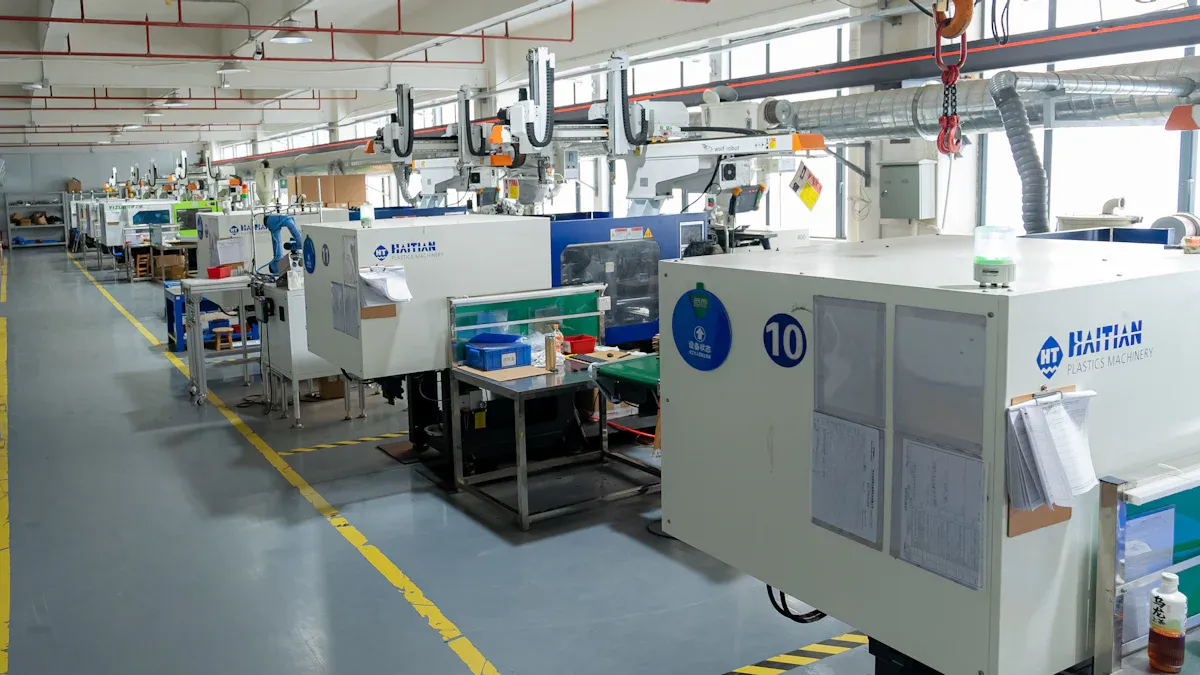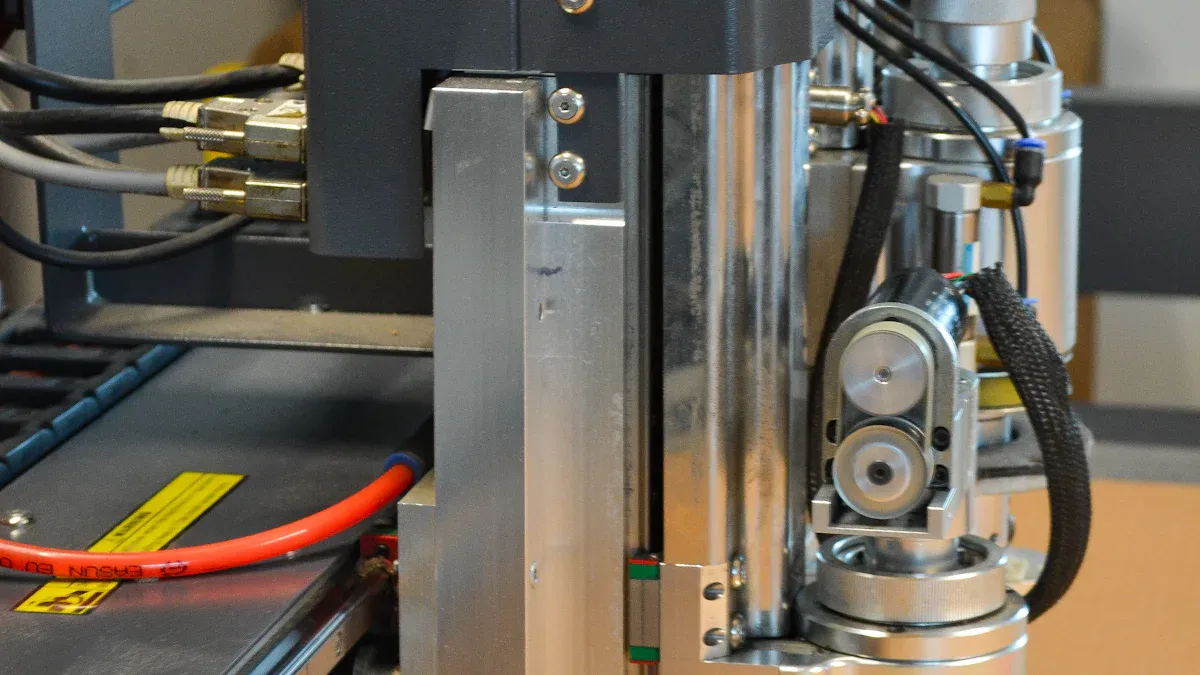
Binder-Free MIM represents a revolutionary approach to sustainable powder processing. This innovative technique eliminates the need for binders, reducing material waste and enhancing the efficiency of production. Companies adopting Binder-Free MIM experience immediate benefits, such as lower energy consumption and improved product quality. As industries prioritize sustainability, this method stands out as a key player in transforming traditional manufacturing practices.
Key Takeaways
- Binder-Free MIM eliminates the need for binders, reducing material waste and enhancing production efficiency.
- This method lowers energy consumption, leading to reduced operational costs and a smaller carbon footprint.
- Binder-Free MIM supports a circular economy by allowing for efficient recycling of unused powders.
- Industries like automotive, aerospace, and medical devices benefit from the high precision and strength of components produced using Binder-Free MIM.
- The process allows for the creation of complex geometries, making it ideal for intricate designs in various applications.
- Adopting Binder-Free MIM can improve a company’s sustainability credentials, appealing to environmentally conscious consumers.
- Investing in Binder-Free MIM may require specialized equipment, but the long-term benefits often outweigh initial costs.
- Future innovations in materials and techniques promise to enhance the capabilities and applications of Binder-Free MIM.
Understanding Binder-Free MIM
Definition and Principles
Binder-Free MIM, or Metal Injection Molding, represents a significant advancement in powder processing technology. Unlike traditional Metal Injection Molding, which relies on binders to hold metal powders together, Binder-Free MIM eliminates this need. This approach enhances sustainability by reducing waste and improving the efficiency of the manufacturing process.
The fundamental principles that differentiate Binder-Free MIM from traditional methods can be summarized in the following table:
| Feature | Metal Injection Molding (MIM) | Metal Binder Jetting (MBJ) |
|---|---|---|
| Process Type | Molding and sintering | Additive manufacturing |
| Design Flexibility | Constrained by mold design limitations | Greater design freedom and flexibility |
| Feedstock Preparation | Mixture of metal powder and polymer binder | Fine metal powder with a liquid binding agent |
| Production Method | High-pressure injection into molds | Layer-by-layer printing with binding agent |
| Post-Processing | Thermal or solvent-based debinding followed by sintering | Sintering in an industrial furnace |
The Process of Binder-Free MIM
The Binder-Free MIM process involves several critical steps that ensure the production of high-quality components. The main steps include:
- Mixing: Metallic powders are combined to create a feedstock.
- Injection Molding: The feedstock is injected into a mold to produce green parts.
- Debinding: The binder is removed from the green parts to create brown parts.
- Sintering: The brown parts are heated in a high-vacuum atmosphere to form the final components.
This streamlined process allows manufacturers to produce complex geometries with high precision while minimizing material waste.
Key Materials Used
The success of Binder-Free MIM relies heavily on the selection of appropriate materials. Various metal powders are utilized, each offering unique properties suited for specific applications. Commonly used materials include:
| Alloy Type | Properties and Applications |
|---|---|
| Cobalt Alloys | Good magnetic properties, corrosion and wear resistance, used in jet engine turbines and medical implants. |
| Copper Alloys | High thermal and electrical conductivity, used in heat exchangers and electrical connectors. |
| Nickel Alloys | High-temperature corrosion resistance, used in aerospace applications like jet turbines and chemical processing. |
Additionally, gas atomization produces metal powders from various materials, including:
- Steel alloys
- Titanium alloys (e.g., Ti6Al4V)
These materials exhibit excellent flowability and sintering behavior, making them ideal for Binder-Free MIM applications.
The material property requirements for successful Binder-Free MIM processing include:
| Requirement | Description |
|---|---|
| High volume incorporation | Ability to incorporate a high volume of fine metal powders, typically 60% by volume. |
| Coherent mass formation | Must form a coherent mass that can be plastified and injection molded at elevated temperatures. |
| Environmentally friendly removal | Should allow removal of the main binder constituent in a reasonably short, environmentally friendly process. |
| Strength after debinding | Must provide enough strength after debinding through the backbone binder. |
| Granular form | Should be supplied in a regular granular form that can easily be fed into an injection molding machine. |
| Consistent properties | Needs to have consistent, uniform properties from batch to batch. |
| Recyclability | Capable of producing runners and green scrap that are easily recyclable. |
| Cost-effectiveness | Must be cost-effective. |
By understanding these principles, processes, and materials, industries can leverage Binder-Free MIM to enhance their manufacturing capabilities while promoting sustainability.
Environmental Benefits of Binder-Free MIM

Reduction in Waste Generation
Binder-Free MIM significantly reduces waste generation compared to traditional powder processing methods. By eliminating binders, manufacturers minimize the amount of material that typically becomes waste during production. Traditional methods often require extensive debinding processes, which can lead to substantial scrap material. In contrast, Binder-Free MIM allows for a more efficient use of raw materials.
- Key Points:
- No binders mean less material waste.
- Efficient recycling of unused powders.
- Reduced need for post-processing waste management.
This reduction in waste not only conserves resources but also lowers disposal costs for manufacturers. Companies adopting Binder-Free MIM can contribute to a circular economy by recycling excess materials back into the production cycle.
Lower Energy Consumption
Energy consumption is a critical factor in sustainable manufacturing. Binder-Free MIM offers a more energy-efficient alternative to traditional methods. The absence of binders simplifies the production process, which leads to lower energy requirements during both the injection molding and sintering stages.
- Benefits of Lower Energy Consumption:
- Reduced operational costs for manufacturers.
- Decreased reliance on fossil fuels.
- Lower overall energy demand contributes to sustainability goals.
By optimizing energy use, Binder-Free MIM not only enhances profitability but also aligns with global efforts to reduce energy consumption in manufacturing.
Decreased Carbon Footprint
The environmental impact of manufacturing processes is often measured by their carbon footprint. Binder-Free MIM contributes to a decreased carbon footprint through several mechanisms. First, the reduction in waste generation and energy consumption directly correlates with lower greenhouse gas emissions.
- Factors Contributing to a Decreased Carbon Footprint:
- Efficient use of materials reduces the need for raw material extraction.
- Lower energy consumption translates to fewer emissions from power generation.
- Streamlined processes minimize transportation emissions associated with waste disposal.
As industries strive to meet sustainability targets, adopting Binder-Free MIM can play a pivotal role in reducing their overall environmental impact. This method not only supports manufacturers in achieving compliance with regulations but also enhances their reputation as environmentally responsible entities.
Comparison with Traditional Powder Processing Methods

Traditional MIM vs. Binder-Free MIM
The differences between traditional Metal Injection Molding (MIM) and Binder-Free MIM are significant. Traditional MIM involves several steps that include powder making, forming, sintering, and post-processing. In contrast, Binder-Free MIM streamlines this process. The following table highlights the key differences in process steps:
| Traditional MIM Steps | Binder-Free MIM Steps |
|---|---|
| Powder making | Mixing |
| Forming | Molding |
| Sintering | Sintering |
| Post-processing | Degreasing |
This streamlined approach in Binder-Free MIM not only enhances efficiency but also reduces the complexity of production.
Cost-Effectiveness Analysis
Cost considerations play a crucial role in the adoption of Binder-Free MIM. While initial investments may be higher for Binder-Free MIM due to specialized equipment, the long-term benefits often outweigh these costs. The following table summarizes the impact of Binder-Free MIM on various cost components:
| Cost Component | Impact of Binder-Free MIM |
|---|---|
| Initial Investment | Higher cost of Binder Jetting machines compared to conventional MIM-grade machines. |
| Material Utilization | Similar material costs, but potential marginal increase for Binder Jetting powders due to conditioning. |
| Labor Costs | Potential reduction due to improved efficiency and reduced lead times. |
| Operational Expenses | Lower tooling costs and faster production times can reduce overall operational expenses. |
Additionally, Binder-Free MIM can lead to lower operational expenses through faster production times and reduced tooling costs. This makes it a viable option for manufacturers looking to optimize their processes.
Quality and Performance Metrics
Quality and performance metrics are essential for evaluating the effectiveness of Binder-Free MIM. The following table outlines key metrics used to assess parts produced by this method:
| Metric | Description |
|---|---|
| Vickers hardness | A measure of the hardness of the material, indicating its resistance to deformation. |
| Defects | Includes the presence of cracks and binder separation, which can affect the integrity of the part. |
| Simulation software | Tools like Moldflow are used to predict filling and quality outcomes during the MIM process. |
Binder-Free MIM components achieve impressive mechanical properties. For instance, they can reach a density of 97-98% after sintering, comparable to traditional MIM. However, the ductility may be lower due to the coarser microstructure resulting from the sintering process. This difference highlights the importance of selecting the appropriate method based on the desired application.
Applications of Binder-Free MIM Across Industries
Automotive Industry
The automotive industry has embraced Binder-Free MIM for its ability to produce complex components efficiently. This method allows manufacturers to create parts that meet stringent performance standards while minimizing waste. Common automotive components manufactured using Binder-Free MIM include:
- Brake components
- Rocker arms
- Injector nozzles
- Fittings and connectors
- Turbochargers
- Fuel injectors
- Control components (such as clock mounts, entry locks, knobs, and levers)
- Valve lifters
These components benefit from the high precision and strength that Binder-Free MIM offers, making them ideal for demanding automotive applications.
Aerospace Sector
In the aerospace sector, Binder-Free MIM provides numerous advantages that enhance manufacturing capabilities. The following table outlines key benefits of using this method in aerospace applications:
| Advantage | Description |
|---|---|
| Lightweight and Strong Parts | MIM produces lightweight, strong aerospace parts with complex shapes that traditional methods cannot easily make. |
| High Precision and Tolerances | The process delivers high precision and tight tolerances, ensuring parts fit perfectly and perform reliably in tough conditions. |
| Material Versatility | MIM supports many metals like titanium and superalloys, allowing engineers to choose the best material for each aerospace need. |
| Reduced Waste and Costs | Using MIM reduces waste, lowers production costs for medium to high volumes, and speeds up manufacturing of small, detailed parts. |
| Design Freedom | MIM combines the design freedom of plastic injection molding with the strength and durability of metal. |
| Consistent Quality | Engineers can produce small, intricate components at high volumes with consistent quality. |
| Complex Shapes | The process supports complex shapes and fine details that challenge traditional metalworking. |
| Enhanced Structural Integrity | Components can be joined or brazed into larger assemblies, enhancing structural integrity and functionality. |
| Intricate Geometries | MIM enables the production of intricate geometries and tight tolerances, essential for high-stress aerospace applications. |
| Improved Fuel Efficiency | High-precision MIM parts improve fuel efficiency, aerodynamics, and part lifespan, reducing maintenance needs and downtime. |
These advantages make Binder-Free MIM a preferred choice for aerospace manufacturers seeking to optimize performance and reduce costs.
Medical Devices
The medical device industry also benefits significantly from Binder-Free MIM. This method allows for the production of high-quality components that meet strict regulatory standards. Some medical devices currently produced using Binder-Free MIM include:
- Knee rehabilitation devices
- Laser surgery machines
- Arthroscopic surgery devices
- Orthodontic brackets
- Screw dental implants
- Ultrasonic endodontic tips
- Scaler tips
- Surgical fixation devices
- Surgical tools
- Vascular stents
- Hearing aids
- Scissors and sewing units
- Drug delivery devices
- Surgical clamps
- Knife shaft tools
- Oxygen concentrators
The process ensures high strength and biocompatibility, enhancing the efficiency and quality of medical device manufacturing. Many MIM products have acceptable properties and performance for use in clinical trials, making them suitable for various medical applications.
Consumer Products
Binder-Free MIM has made significant inroads into the consumer products sector, offering manufacturers a way to produce high-quality components efficiently. This method allows for the creation of intricate designs that meet consumer demands for both functionality and aesthetics. The following are key applications of Binder-Free MIM in consumer products:
- Household Appliances:
- Components such as knobs, handles, and brackets benefit from the precision and durability of Binder-Free MIM.
- Electronics:
- The production of casings, connectors, and internal components for devices like smartphones and laptops showcases the versatility of this method.
- Sporting Goods:
- Items such as bicycle parts, golf club heads, and fishing reels leverage the strength and lightweight properties of Binder-Free MIM components.
- Jewelry:
- The ability to create complex shapes allows for unique designs in rings, bracelets, and pendants.
The advantages of using Binder-Free MIM in consumer products include:
| Advantage | Description |
|---|---|
| Design Flexibility | Manufacturers can create intricate designs that traditional methods may not easily achieve. |
| Cost Efficiency | Reduced material waste and lower energy consumption lead to overall cost savings. |
| Enhanced Durability | Parts produced exhibit high strength and resistance to wear, increasing product lifespan. |
| Rapid Production | Shorter lead times enable faster market entry for new products, meeting consumer demands swiftly. |
Tip: Companies looking to adopt Binder-Free MIM should consider their specific product requirements. Evaluating the material properties and design complexities can help determine the feasibility of this method.
The consumer products industry increasingly values sustainability. Binder-Free MIM aligns with this trend by minimizing waste and energy consumption. As consumers become more environmentally conscious, manufacturers can leverage Binder-Free MIM to enhance their sustainability credentials.
Future Prospects of Binder-Free MIM
Innovations on the Horizon
The future of Binder-Free MIM holds exciting innovations that promise to enhance its capabilities. Researchers and manufacturers are exploring advanced materials and techniques to improve the process. For instance, the integration of artificial intelligence (AI) in the design and production phases can optimize parameters, leading to higher precision and reduced defects. Additionally, the development of new metal alloys specifically designed for Binder-Free MIM can expand its application range. These innovations will likely drive further adoption across various industries.
Potential Market Growth
Market forecasts indicate robust growth for the Binder-Free MIM sector. The Metal Injection Molding (MIM) market is projected to grow at a compound annual growth rate (CAGR) of 11.9% from 2025 to 2032. The market size was valued at USD 5.51 billion in 2024 and is expected to reach nearly USD 13.56 billion by 2032. This growth reflects the increasing demand for efficient and sustainable manufacturing processes. As industries prioritize sustainability, Binder-Free MIM stands out as a viable solution, attracting investments and interest from various sectors.
Challenges and Solutions
Despite its promising future, Binder-Free MIM faces several challenges. One significant hurdle is the need for specialized equipment and expertise. Many manufacturers may hesitate to invest in new technologies without a clear understanding of the benefits. To address this, industry stakeholders should focus on education and training programs that highlight the advantages of Binder-Free MIM.
Another challenge involves material limitations. While current metal powders work well, ongoing research is essential to develop new materials that can withstand demanding applications. Collaborations between academia and industry can foster innovation in this area.
Finally, scaling production while maintaining quality remains a concern. Implementing stringent quality control measures and leveraging automation can help manufacturers achieve consistent results.
Binder-Free MIM plays a crucial role in advancing sustainable powder processing. This innovative method reduces waste and energy consumption, aligning with the growing demand for environmentally friendly manufacturing practices. Sustainability remains vital in modern manufacturing, as industries strive to minimize their environmental impact.
Manufacturers should consider adopting Binder-Free MIM to enhance their production processes and contribute to a more sustainable future. Embracing this technology can lead to significant benefits, including improved efficiency and reduced costs.
FAQ
What is Binder-Free MIM?
Binder-Free MIM is a manufacturing process that eliminates the use of binders in Metal Injection Molding. This method enhances sustainability by reducing waste and improving production efficiency.
How does Binder-Free MIM reduce waste?
By removing binders, Binder-Free MIM minimizes material waste during production. This process allows for more efficient use of raw materials, contributing to a circular economy.
What industries benefit from Binder-Free MIM?
Binder-Free MIM benefits various industries, including automotive, aerospace, medical devices, and consumer products. Each sector utilizes this method for its efficiency and sustainability.
Are there any challenges in adopting Binder-Free MIM?
Yes, challenges include the need for specialized equipment and expertise. Manufacturers may also face material limitations and the need for stringent quality control.
How does Binder-Free MIM compare to traditional MIM?
Binder-Free MIM streamlines the production process by eliminating binders, leading to reduced complexity, lower energy consumption, and less waste compared to traditional MIM.
What materials are commonly used in Binder-Free MIM?
Common materials include cobalt alloys, copper alloys, and nickel alloys. These materials offer unique properties suitable for various applications in Binder-Free MIM.
What are the future prospects for Binder-Free MIM?
The future looks promising, with innovations in materials and processes expected to enhance Binder-Free MIM’s capabilities. Market growth is anticipated as industries prioritize sustainable manufacturing.
How can manufacturers implement Binder-Free MIM?
Manufacturers can start by evaluating their product requirements and investing in training programs. Collaborating with experts can facilitate a smoother transition to Binder-Free MIM technology.
